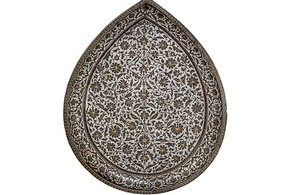A mysterious and uniquely designed tray from the historic city of Bidar in South India is at risk of being exported from the UK unless a buyer can be found.
Published 18 January 2019
From:Department for Digital, Culture, Media & Sport and Michael Ellis MP

A mysterious and uniquely designed tray from the historic city of Bidar in South India is at risk of being exported from the UK unless a buyer can be found.
The ‘Tear Shaped Bidri Tray’, which is believed to have been made in the first half of the 17th century by an unknown craftsman, has been blocked from export by Michael Ellis, Minister for Arts, Heritage and Tourism, to provide an opportunity to keep it in the country.
The tray, deemed to be of a rare size and shape and unparalleled finesse, is in a metalworking technique known as ‘Bidri’, the name deriving from the capital city of the Bahmanid sultanate of the Deccan which was one of the major Muslim kingdoms of medieval India.
It is also believed to be one of only two bidri objects to have its entire outer surface covered in silver inlay, decorated through a complex intertwining of scrolling lines bearing leaves and stylised flowers.
17th century Bidriware is rare in any collection in the world, with the vast majority of pieces in UK public and private collections dating from the 19th century. Even the Jagdish and Kamla Mittal Museum of Indian Art, which has the finest collection of Bidriware in the world, does not own a tray of this type.
Michael Ellis, Minister for Arts, Heritage and Tourism, said:
The Tear Shaped Bidri Tray highlights the style, detail and innovation of metalware produced on the subcontinent during this influential period in world history.
When considering its unique nature, it is right that we do what we can to preserve this valuable item for the nation.
Most of the tray’s ownership history is unknown. It is recorded as having been acquired by the London-based antique dealer Anthony “Tobi” Jack in London by at least 1974, and was owned by the dealer Bashir Mohamed from 1974 to 2017.
Experts also believed that the tray highlights the Indian superiority in metallurgical knowledge, or scientific study of metals, at the time it was made. Appreciation of the zinc alloy technique of bidri may be indirectly linked to sharing with England how to produce metallic zinc, or carry out zinc smelting, on an industrial scale. This would ultimately lead to a transformation in English industrial production around a century later.
The decision to defer the export licence follows a recommendation by the Reviewing Committee on the Export of Works of Art and Objects of Cultural Interest, administered by The Arts Council. They made their recommendation on the grounds that the item is of outstanding aesthetic importance and significance for the study of Indian and Deccan decorative arts.
Chairman of the Reviewing Committee on the Export of Works of Art and Objects of Cultural Interest, Sir Hayden Phillips, said:
This 17th century Indian tray is exquisite; both in the beauty of its appearance, in the shape of a tear, and in the manner of its creation. It fully reflects the sophistication of Deccan design in the region’s monuments and interiors.
We were unanimous in our view that the tray was of outstanding aesthetic importance and of outstanding significance to the study of Bidri ware”.
The decision on the export licence application for the item will be deferred until 17 April 2019. This may be extended until 17 July 2019 if a serious intention to raise funds to purchase it is made at the recommended price of £75,000, plus VAT.
Organisations or individuals interested in purchasing the tray should contact the RCEWA on 0845 300 6200.
ENDS
Notes to editors
Details of the item are as follows:
- Tear shaped Bidri tray
- Matching offer: £75,000 plus VAT
- Blackened zinc alloy inlaid with silver and brass,
- Measurements: length 35cm, width 29cm, height 3 cm.
The Reviewing Committee on the Export of Works of Art and Objects of Cultural Interest is an independent body, serviced by The Arts Council, which advises the Secretary of State for Digital, Culture, Media and Sport on whether a cultural object, intended for export, is of national importance under specified criteria.
The Arts Council champions, develops and invests in artistic and cultural experiences that enrich people’s lives. It supports a range of activities across the arts, museums and libraries – from theatre to digital art, reading to dance, music to literature, and crafts to collections: www.artscouncil.org.uk.
A Buyer’s Premium is an additional percentage charge on the hammer price, which is charged by the auctioneer to cover their expense.
Source: https://www.gov.uk/government/news/unique-tear-shaped-tray-from-17th-century-southern-india-at-risk-of-export
" Twitter: #BidarInfo (@BidarInfo) "

No comments:
Post a Comment